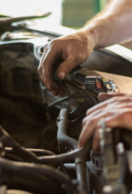Winter is coming. And with the coming of winter comes the age-old question... to warm up the car, or not to warm up the car?
Nowadays with the push-to-start ignition, drivers don't even have to be in their cars to start it running and get the engine warm. It's one thing to get in the car to find the seat and steering wheel already toasty warm, but what about the engine? Will it be damaged if it's driven cold? Or is warming up the car just an old-fashioned idea, irrelevant and wasteful for modern vehicles?
The Origin of Warming Up the Engine
In older cars, the concept of warming up the engine was important because of a vital engine component called the carburetor. Without warming up, the carburetor might not get the proper air/fuel ratio into the engine, potentially causing the car to stall out.
 However, modern cars no longer use carburetors. Electronic sensors inject fuel and air into the engine, and can adjust to temperature conditions without warming up. This shift happened in the 1980s and 1990s, so unless you're still driving a car with a carburetor, there is no purpose to idling the car before driving it.
However, modern cars no longer use carburetors. Electronic sensors inject fuel and air into the engine, and can adjust to temperature conditions without warming up. This shift happened in the 1980s and 1990s, so unless you're still driving a car with a carburetor, there is no purpose to idling the car before driving it.
Driving Cold
Another kernel of truth to the myth of warming up the car is the idea that colder engines get worse fuel economy.
It's true, gas mileage really does decrease in cold weather, and it really does take longer for a cold engine to reach its optimal driving temperature when it's cold out. According to the the EPA, cars are about 12 percent less fuel efficient when the temperature gets under 20 degrees Fahrenheit. Cold engine fluids increase engine and transmission friction, tire pressure decreases, and even battery performance decreases, making it harder to keep the car battery charged in the winter. All of these factors, and more, can have detrimental impacts on fuel economy.
However, the engine will actually heat up much more quickly when it is being driven than when it is idling. The longer cars idle prior to being driven, the more gas they waste. Even cars which get comparatively good gas mileage still have the same fuel waste when they are idling as their gas-guzzling counterparts.
Improving Fuel Economy in the Winter
Since gas mileage does decrease so much during the colder months, and we've established that idling the car isn't a good way to improve it, how can you get better fuel economy when it's cold out? Here are a few ideas:
- Park in the garage instead of on the driveway. This will help the engine and the cabin of the car to be warmer when you get in, and will hopefully prevent ice and frost so that you don't have spend time idling to defrost the windows prior to driving.
- Regularly check your tire pressure and refill tires when necessary.
- Don't overuse seat warmers or window defrosters.
- Take one trip out to multiple places instead of multiple trips so that you drive less on a cold engine.
- Check your owner's manual to find out what type of oil is recommended for your vehicle in cold weather.
To get your vehicle ready for winter, be sure to come in to All in the Wrist Auto for any tune-ups, tires, or oil changes you might need to make sure your cold-weather driving is safe and fuel-efficient.








